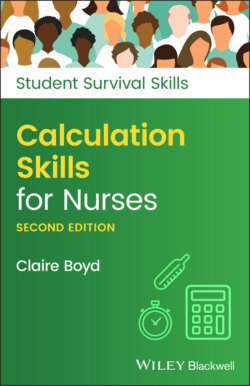Читать книгу Calculation Skills for Nurses - Claire Boyd - Страница 11
ОглавлениеChapter 1 CALCULATIONS SELF‐ASSESSMENT
Calculation Skills for Nurses, Second Edition. Claire Boyd.
© 2022 John Wiley & Sons, Ltd. Published 2022 by John Wiley & Sons Ltd.
LEARNING OUTCOMES
By the end of this chapter you will have a better understanding of your strengths and weaknesses relating to calculations and which sections of the book you should focus on to improve your abilities.
To assess your own calculations ability, it is recommended that you complete the self‐assessment in this chapter. It will help you to identify any area that you have difficulty with, and that you need to brush up on. You can use a calculator but first, why not have a go without one? This is because the NMC states that nurses should not rely too heavily on calculators. Attempting the self‐assessment will also help you to identify your own improvement when you attempt the Knowledge Tests at the end of this book, where everything we have learned throughout the book gets put into practice. Don’t worry if you don’t answer everything correctly first time around: just go to Chapter 2 and Chapter 3 and work through the practice exercises.
Remember the rule of 5s!
Activity 1.1
1 6.7 + 4.9 =
2 119 – 27 =
3 5.91 × 7.42 =
4 8 / 2.5 =
5 Round 0.78 to one decimal place.
6 Round 0.31 to one decimal place.
7 Round 4.72 to one decimal place.
8 Round 2.33 to one decimal place.
9 Round 9.45 to one decimal place.
10 Round 3.44 to one decimal place.
11 Round 2.418 to two decimal places.
12 Round 9.234 to two decimal places.
13 Round 0.915 to two decimal places.
14 Round 0.522 to two decimal places.
15 Round 2.340 to two decimal places.
16 Round 6.711 to two decimal places.
17 Round 0.8255 to three decimal places.
18 Round 1.5868 to three decimal places.
19 Change 39.4 to a whole number.
20 Change 31.7 to a whole number.
21 Change 39.9 to a whole number.
Remember: milligrams are smaller than grams.
1 Change 6000 mg into grams.
2 Change 0.7 micrograms into milligrams.
3 Change 9 micrograms into nanograms.
Remember: micrograms are larger than nanograms.
1 Change 0.03 g into milligrams.
2 Change 2.5 L into millilitres.
Remember: always make it clear if your answer has a decimal point.
1 Change 92 kg into grams.
2 Change 8 kg into grams.
3 Change 64.5 micrograms into milligrams.
4 Change 1527 micrograms into milligrams.
5 Change 0.02 mg into grams.
6 Change 1.2 mg into micrograms.
7 What is 25% of 500 mL?
8 What percentage is 92 of 150?
9 What is 10% of 233?
10 Change to a decimal with one decimal place.
11 Change to a decimal.
12 Change to a decimal with one decimal place.
13 How much stock solution is present in 200 mL of diluted solution if expressing this as a ratio of 1 in 5?
14 How much stock solution is present in 200 mL of diluted solution if expressing this as a ratio of 1:5?
15 How much stock solution is present in 600 mL of diluted solution if expressing this as a ratio of 1 in 3?
16 Write 60% as a fraction.
17 Write 0.75 as a percentage.
18 If you scored 90 out of 180 in a test, what percentage did you score?
19 Change 1 stone into kg.
20 Change 3 lb into kg.
21 Change 80 kg into pounds.
Remember: the mode is the most common figure in a set of figures.
1 What is the mode of 19, 19, 19.2, 20, 20.3 and 25?
2 What is the range of 6, 6.2, 9, 9.5 and 10?
3 What is the mean of 52, 52.4, 61, 67 and 70?
KEY POINT
Understanding your own strengths and weaknesses in calculations.
USEFUL WEB RESOURCES
http://www.bbc.co.uk/schools/gcsebitesize/maths/number
www.mathcentre.ac.uk/students.php/health/arithmetric/rules/resources/
